Thrilling finishes, goalie heroics and a Sky Blue derby: The A-League players who were the difference in Round 24
Mathew Leckie played a pivotal part in Melbourne City claiming an 8-nil win; playing a role in several of his team's goals.
Opinion
Perth Glory have just about managed to limp their way into the 2019-20 A-League finals series, recording two wins and four losses since the restart and pipping Adelaide United to sixth place by just a single point.
The absences of Diego Castro, Gregory Wüthrich and Kim Soo-Beom (in descending order of how much they have been missed) have resulted in a bit of a headache for Tony Popovic, and he’s changed his tactics in response. They find themselves against Ufuk Talay’s Wellington Phoenix, who themselves have been struggling for form with one win, two draws and three losses, although the single victory they had was a 2-1 victory against Perth Glory a few weeks back.
This article is focused on how Perth’s style of play has changed since the restart.
Diego Castro’s loss prompts a formation change
The most obvious issue Perth has had since the restart is the Diego Castro-sized hole in their line-up. He’s been Perth’s key player this season, linking play between the midfield and the attack, combining especially well with Bruno Fornaroli and Joel Chianese. Some stats that show his impact in the final third are his tally of five assists this campaign, while he’s second in the league for smart passes per 90 minutes, smart pass accuracy and key passes.
Having lost this attacking contribution, Popovic has had to change his setup from a 5-2-3 to a 5-3-2 (or 3-4-3 to a 3-5-2 if you prefer). What used to be the front three is now a front two, with the playmaking responsibilities shifting to the additional man in midfield.

Bruno Fornaroli – Perth’s main man
Bruno Fornaroli has now become the target for most of Perth’s play, with his teammates looking to play the ball to him whenever possible. He’s even been the target from goal kicks, which is a bit surprising when you consider his height of 1.75m, but he is capable of using his body to hold off defenders.
The main way he receives the ball is dropping in between the lines to pick up a ball to feet with his back to goal, and it seems the objective is to do a few things:

Joining Fornaroli upfront is usually one of Nick D’Agostino or Gabriel Popovic. D’Agostino has a similar playing style to Fornaroli, and can drop into pockets of space to receive and turn, while also having a bit of pace to run in behind. I’m still not entirely sure about what Popovic’s playing style is – his build and strength suggest he’s a target man, although he’s provided a fair amount of energy to the press and offsets Fornaroli’s positioning.
I’m surprised to have seen so little of Joel Chianese up front, considering his ability to stretch defences in behind with his pace, and he’s been a staple of Perth’s starting three up front for most of the campaign since Chris Ikonomidis injured his ACL. Instead, his involvements have been more as a right-sided wingback.
Behind the attackers, the three midfield roles are clearly defined:
Aside from the midfielders, the wingbacks are also key to how Perth like to play. Perth will often patiently shift the ball side-to-side in order to probe for openings, and due to this, the wingbacks frequently pick up the ball and attempt to move it forwards. The wingbacks have seen a bit of rotation, with the usual starters James Meredith and Ivan Franjic sharing minutes with Dane Ingham and Chianese. They’ve been the most dangerous attacking threat, accounting for four of the eight goals they’ve scored since the restart.
Gregory Wüthrich prompts a shuffle at centreback
It looks Popovic hasn’t figured out his best defensive partnership due to Wüthrich’s absence, while he’s juggling his squad fitness and injuries. As such, he’s rotated heavily, and surprisingly a total of seven players have had minutes at centreback since the restart:
It looks like Mrcela and Malik will play, and any one of Grant, Elrich or Tratt could partner them.
Perth’s high press
Perth employs a high press, and their stats since the restart reflect this playing style – they have allowed their opponents an average of 10.59 passes before a defensive action, which is the third least in the league.
They’ve been fairly successful with the press – they have the highest percentage of their recoveries in the front and middle thirds (61 per cent) and the lowest percentage of recoveries in their defensive third (39 per cent), suggesting that they win the ball further forward on average than the rest of the league.

Ball recovery zones

The press is fairly well organised
Pressing triggers include backward passes or passes played between the centrebacks.
One interesting thing to note is that a lot of the ball recoveries in the middle third of the pitch are actually from the centrebacks, indicative of their high starting position and also their tendency to step forward to cut out play.
While the pressing is well organised, it does have some flaws.
Wingbacks covering ground
The wingbacks have a responsibility to push up the pitch to close down the opposition fullback. When their opponent plays as a wingback – ie. is pushed further forwards – they generally have an easier time, with less distance for the wingback to meet them. Against a four-at-the-back system like Wellington’s, however, they can often struggle for two reasons:
Here, Wellington Phoenix are able to play through the press easily, as they find the fullback Fenton unmarked through a bounce pass from Devlin. Glory wingback Ingham had previously been tracking the winger Piscopo, and has to switch to press Fenton after he receives the ball. The covering centre-back Grant has to then step up to cover Piscopo, and leaves them 2v2 at the back.
The Adelaide fullback receives the ball and can carry the ball forward as his direct opponent Ingham is preoccupied with the winger Halloran. As he gets closer, Ingham looks to engage, which opens up space for Halloran to proceed unmarked. The Adelaide striker Opseth drops deep and Tratt cannot engage both of them, and they work the overload to release Halloran in behind to score.
Space in the centre
Juande usually doesn’t join the press, instead positioning himself to sweep up in the zone behind the midfield. He plays centrally, and covers players who enter the zone in between midfield and defence. Juande’s role is interesting – he’s often zonally oriented and not involved in the press, which can leave an easy option for the opposition, while other times he’s tracking a man into the half-spaces which leaves the central areas open.
The outside centre-backs have the responsibility of covering behind the wingbacks, and also on either side of Juande. They’ll often step up quite aggressively to track any opposition players who drop deep in between the lines or in the half-spaces.
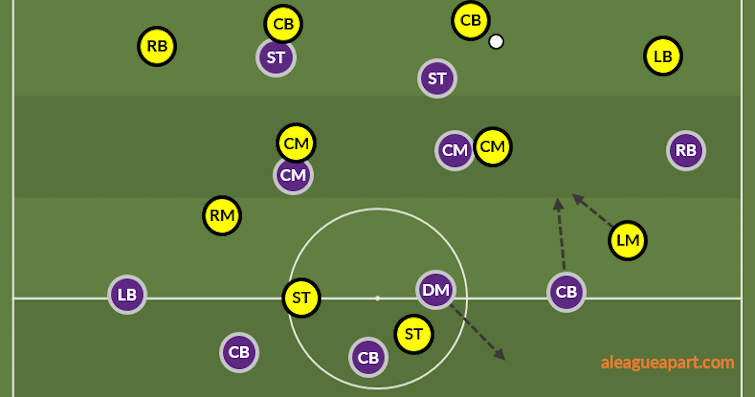
When the centreback steps up, Juande will often slot into the backline to cover.
The defence frequently has trouble with covering all options. The press naturally means that most players move further forwards, and as a result, they are often left 2v2 or 3v3 at the back, especially when the opposition overloads one flank. It also makes it difficult for a centre-back to push out comfortably without opening space in behind for a direct ball into an unmarked player.
Press broken vs Melbourne Victory
Their defensive performance against Victory – all four goals conceded – showed how susceptible the space behind the midfielders can be when the press is broken.
This passage of play that led to the 2-0 penalty came from a Perth press:
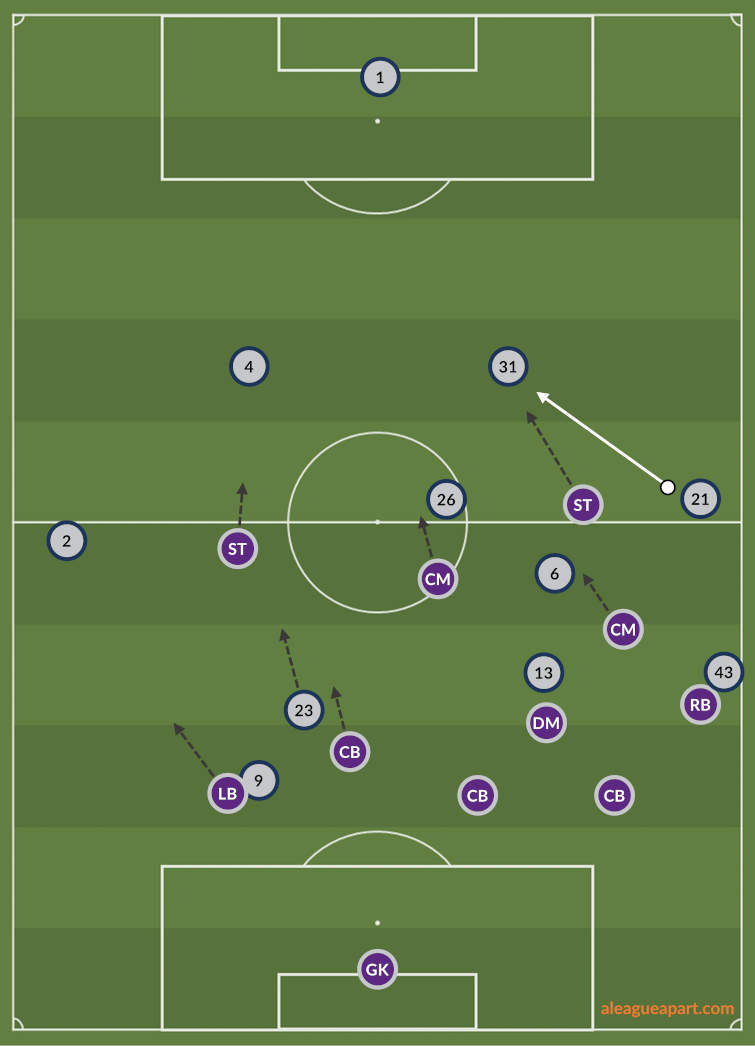
As the ball is played backwards, the Perth press is initiated. The front four push forward to cut passing options, and the left-back Ingham pushes forward to cut off the no.2. The left-sided centre-back Elrich pushes forward to match no.23 dropping short.
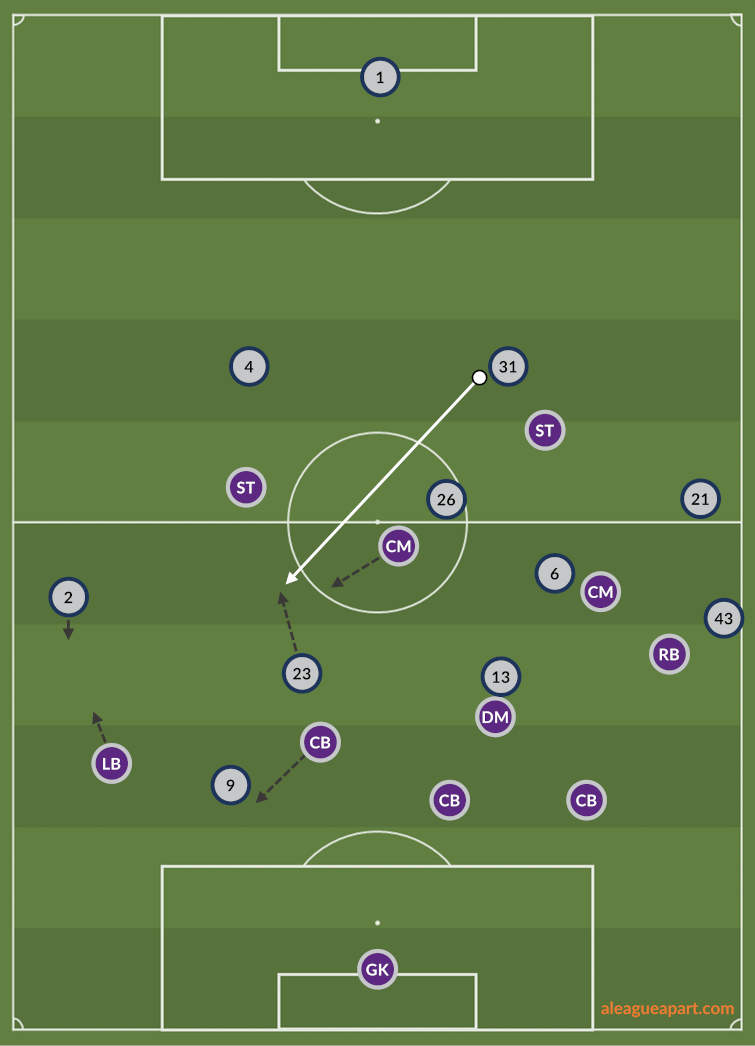
Ingham pushing out to meet the no.2 means that the CB Elrich has to instead drop to cover the no.9, while Juande has stayed with the opposition no.13, allowing Rojas to receive the ball through the press and turn.
About eight seconds after receiving the ball, Melbourne Victory win a penalty.
The 3-0 goal also arose from playing through the Perth press:
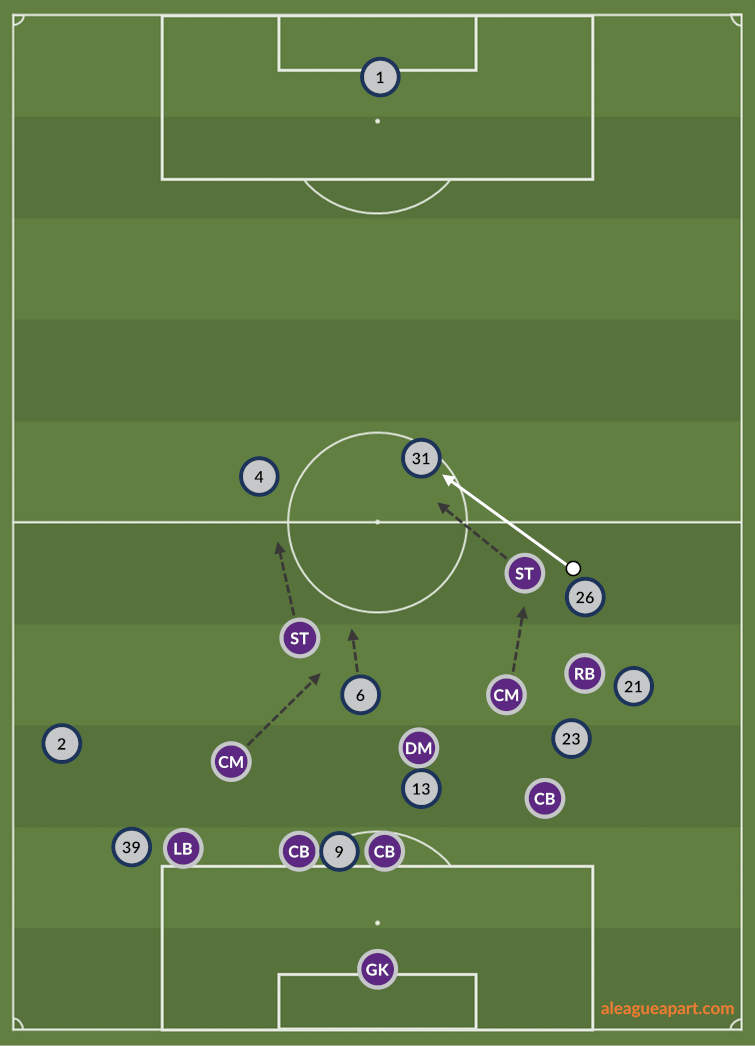
The ball is played backwards, triggering the Perth press. The front four push up.

The ball gets played forwards before being bounced back and miscontrolled, encouraging the press further. Ingham pushes up and Elrich moves over to cover no.39. No.9 and no.13 move into positions behind the press.
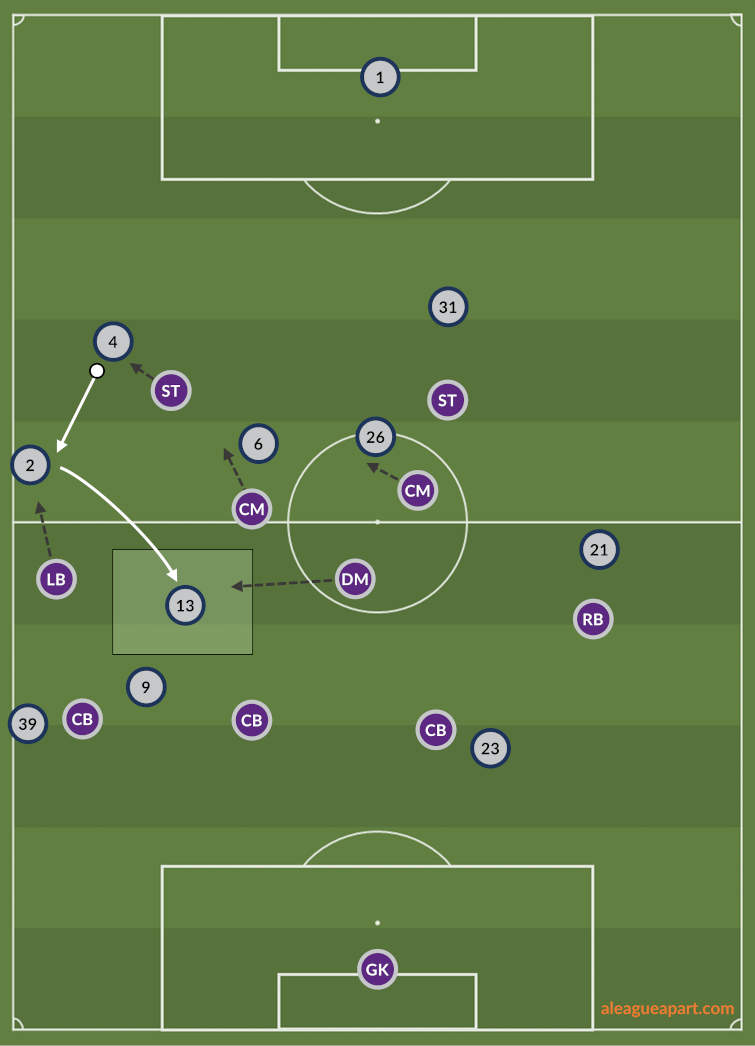
Juande has positioned himself zonally behind his midfielders but is slow to react to no.13 coming over, while the central centre-back Mrcela can’t push forward enough close the gap without leaving a huge gap centrally.
Kirdar manages to turn on the ball, play a simple one-two and Rojas receives the ball and scores.
Summary
Perth’s opponent in the elimination final is Wellington, whom they lost to a few weeks back. It was a close game with a penalty proving to be what separated the teams, and Perth didn’t have their best starting eleven on the pitch.
With Gary Hooper out of contention for the Nix, they might feel like they have a chance. They’ll have to be mindful of how they protect the centre of the pitch behind the first two waves of the press, as well as how they cope with 2v1s on the flanks.
However, since the restart, the four games they’ve played against teams in four-at-the-back formations have resulted in a record of 11 goals conceded – five v Adelaide, four v Victory, two v Wellington and zero v Mariners It seems like it could be an uphill battle.
I wonder if Popovic might consult the 5-2-3 formation again which had them record a 4-2 win against Wellington in February – a game in which Diego Castro was a notable absentee.